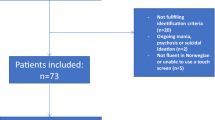Abstract
Aberrant central neurological functioning is believed to contribute to the abnormal sensations of fibromyalgia (FM). Most patients with FM complain of diminished cognitive function. This study sought to compare objective cognitive function between FM and healthy controls at baseline and to determine if symptomatic improvement was related to objective cognitive improvement. Automated neuropsychological assessment metrics (ANAM) was used to quantify neurocognitive function. Performance on ANAM was compared between subjects with FM, musculoskeletal pain, and pain-free controls. Ten separate FM subjects completed an 8-week comprehensive treatment program. Serial testing with ANAM and the Fibromyalgia Impact Questionnaire was conducted. Statistical analysis was performed using repeated Wilcoxon signed rank tests. No differences were noted on ANAM between controls and subjects with pain disorders. A clinical improvement (FIQ median change 33.9, P = 0.002) was noted with treatment without concomitant change in ANAM scores. No cognitive impairment in FM was demonstrated using ANAM.
Similar content being viewed by others
References
Katz R, Heard A, Mills M, Leavitt F (2004) The prevalence and clinical impact of reported cognitive difficulties (fibrofog) in patients with rheumatic disease with and without fibromyalgia. J Clin Rheumatol 10(2):53–58
Glass JM, Park DC (2001) Cognitive dysfunction in fibromyalgia. Curr Rheumatol Rep 3(2):123–127
Grace GM, Nielson WR, Hopkins M, Berg MA (1999) Concentration and memory deficits in patients with fibromyalgia syndrome. J Clin Exp Neuropsychol 21(4):477–487
Landro NI, Stiles TC, Sletvold H (1997) Memory functioning in patients with primary fibromyalgia and major depression and healthy controls. J Psychosom Res 42(3):297–306
Park DC, Glass JM, Minear M, Crofford LJ (2001) Cognitive function in fibromyalgia patients. Arthritis Rheum 44(9):2125–2133
Dick B, Eccleston C, Crombez G (2002) Attentional functioning in fibromyalgia, rheumatoid arthritis, and musculoskeletal pain patients. Arthritis Rheum 47(6):639–644
Suhr J (2003) Neuropsychological impairment in fibromyalgia: relation to depression, fatigue, and pain. J Psychosom Res 55:321–329
Bleiberg J, Kane R, Reeves D et al (2000) Factor analysis of computerized and traditional tests used in mild brain injury research. Clin Neuropsychol 14(3):287–294
Kay G, Berman B, Mockoviak S, Morris C, Reeves D et al (1997) Initial and steady-state effects of diphenhydramine and loratadine on sedation, cognition, mood, and psychomotor performance. Arch Intern Med 157(20):2350–2356
Farmer K, Cady R, Bleiberg J, Reeves D (2001) An open label study to evaluate the effects of sumatriptan nasal spray (20 mg) on cognitive efficiency during migraine. Headache 41(4):377–384
Bleiberg J, Cernich AN, Cameron K, Sun W, Peck K, Ecklund LP, et al (2004) Duration of cognitive impairment after sports concussion. Neurosurgery 54(5):1073–1080
Farmer K, Cady R, Bleiberg J, Reeves D (2000) A pilot study to measure cognitive efficiency during migraine. Headache (40)8:657–661
Roebuck-Spencer TM, Yarboro C, Lapteva L, Frisch D, Nowak M, Weickert TW, Ilei G, Bleiberg J (2004) The contribution of cognitive versus non-cognitive factors to ANAM performance in a Lupus population. Arch Clin Neuropsychol 19(7):947–948 (Abstract)
Wolfe F, Smythe HA, Yunus M et al (1990) The American College of Rheumatology 1990 criteria for the classification of fibromyalgia. Report of the multicenter criteria committee. Arthritis Rheum 33:160–172
Spreen O, Strauss E (1998) A compendium of neuropsychological tests: administration, norms, and commentary, 2nd edn. Oxford University Press, New York
Golden CJ (1978) Stroop color and word test. Western Psychological Services, Los Angeles
Radloff LS (1997) The CES-D scale: a self-report depression scale for research in the general population. Appl Psychol Meas 1:385–401
Callahan LF, Kaplan MR, Pincus T (1991) The beck depression inventory, center for epidemiological studies depression scale (CES-D), and general well-being schedule depression subscale in rheumatoid arthritis. Arthritis Care Res 4(1):3–11
Ercolani M, Trombini G, Chattat R, Cervini C, Piergiacomi G, Salaffi F, Zeni S, Marcolongo R (1994) Fibromylagic syndrome: depression and abnormal illness behavior. Multicenter investigation. Psychother Psychosom 61(3–4):178–186
Wilkinson GS (1993) Wide range achievement test (WRAT-3). Psychological Corporation, Wilmington
Burckhardt C, Clark S, Bennett R (1991) The fibromyalgia impact questionnaire: development and validation. J Rheumatol 18:728–733
Fallon J, Bujak D, Guardino S, Weinstein A (1999) The fibromyalgia impact questionnaire: a useful tool in evaluating patients with post-lyme disease syndrome. Arthritis Care Res 12(1):42–47
Goldenberg D, Mayskiy M, Mossey C, Ruthazer R, Schmid C (1996) A randomized double-blind crossover trial of fluoxetine and amitriptyline in the treatment of fibromyalgia. Arthritis Rheum 39:1852–1859
Box GEP, Cox DR (1964) An analysis of transformations. J R Stat Soc B26:211–243
Bleiberg J, Cernich AN, Cameron KL, Sun W, Peck K, Uhorchak K, Reeves DL, Ecklund J, Sparling MB, Warden D (2004) Duration of cognitive impairment following sports concussion. Neurosurgery 54(4):1–6
Bleiberg J, Garmoe WS, Halpern EL, Reeves DL, Nadler JD (1997) Consistency of within-day and across-day performance after mild brain injury. Neuropsychiatry Neuropsychol Behav Neurol 10(4):247–253
Farmer K, Cady RK, Reeves D, Bleiberg J (2003) Cognitive efficiency following migraine therapy. In: Olesen J, Steiner TJ, Lipton RB (eds) Reducing the burden of headache: frontiers in headache research. Oxford University Press, New York
Acknowledgments
The study group would like to acknowledge the efforts of Teresa Hunt, Cognitive Behavioral Therapist, Nancy Shaw, Physical Therapist, and Daniel Frisch, Neuroscience Research Associate for their efforts. This study would not have been possible without the grant support from the MedStar Research Institute and Pfizer Pharmaceuticals.
Author information
Authors and Affiliations
Corresponding author
Rights and permissions
About this article
Cite this article
Walitt, B., Roebuck-Spencer, T., Bleiberg, J. et al. Automated neuropsychiatric measurements of information processing in fibromyalgia. Rheumatol Int 28, 561–566 (2008). https://doi.org/10.1007/s00296-007-0487-2
Received:
Accepted:
Published:
Issue Date:
DOI: https://doi.org/10.1007/s00296-007-0487-2



